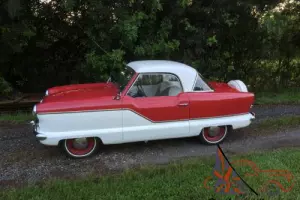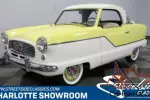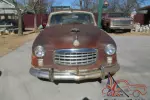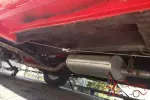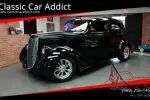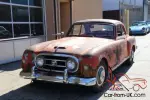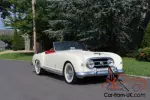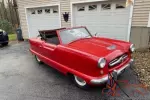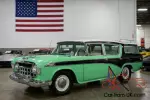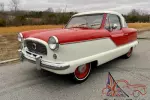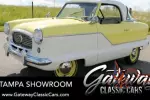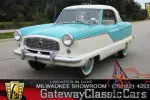Classic Cars / Nash / Car for sale
1959 Nash Series III Metropolitan
Sale price: $7877 Make an offer
Car location: United States
Sale type: Fixed price listing
Technical specifications, photos and description:
- Make:
- Nash
- Model:
- Series III Metropolitan
- Year:
- 1959
- Type:
- Coupe
- Color:
- Red and Cream
- Mileage:
- 15,000
- Transmission:
- Manual
- Fuel Type:
- Gasoline
- Trim:
- hard top
- Interior Color:
- black and white
- Vehicle Title:
- Clear
- Got questions?
- Ask here!
1959 Nash Series III Metropolitan for sale
Current customer rating:
This Series III Metro is up for your consideration. The auction will start at $100 and have a low reserve. This is a running and stopping. kind of daily driver. Take it to the local car show and be the talk of the town. The Metro's popularity is on the rise with it being used in pop videos and pinball games of late.
This is not a concourse quality car.
However. with a little love and attention. you can definitely win some local car shows with it. It is ready to jump in and drive. Many fresh parts. Car has been garage kept for most of its life. The title shows miles as "exempt"! however. the 15 k miles on the odometer are believed to be actual.
Look close at the photos!!!
Happy Bidding! Car is Located in Jupiter. FL.
Feel free to inspect before bidding.
You will like what you see.
Any questions. Call Doug at .
Nash Metropolitan
From Wikipedia. the free encyclopedia
Jump to:
navigation .
search
Metropolitan
1957 Metropolitan
Overview
Manufacturer
Austin
( BMC )
Also called
Hudson
Metropolitan
Metropolitan by
American Motors
Austin Metropolitan
Production
1953–1961
Assembly
Longbridge
.
Birmingham .
West Midlands . England
Designer
William J. Flajole
Body and chassis
Class
Economy car
Subcompact car
Body style
2-door
hardtop
2-door
convertible
Layout
FR layout
Powertrain
Engine
1. 00
cc
(1. 2
L )
Austin
A 40
I 4
1. 00 cc (1. 5 L)
B-Series
I 4
Transmission
3-speed
manual
Dimensions
Wheelbase
85 in (2. 59 mm)
Length
149. 5 in (3. 97 mm) [1]
Width
61. 5 in (1. 62 mm)
Height
54. 5 in (1. 84 mm) [2]
Curb weight
1. 85 lb (810 kg) (base)
The Nash Metropolitan is an
automobile
that was sold from 1953 to 1961.
It conforms to two classes of vehicle:
economy car
[3]
and
subcompact car .
[4][5][6][7][8]
In today's terminology the Metropolitan is a “subcompact”. but this category had not yet come into use when the car was made.
[9]
At that time. it was variously categorized. for example as a "small automobile" as well as an "economy car".
The Metropolitan was also sold as a Hudson when
Nash
and
Hudson
merged in 1954 to form the
American Motors Corporation
(AMC). and later as a standalone
marque
during the
Rambler
years. as well as in the United Kingdom and other markets.
1957 Hudson badged Metropolitan
1961 Metropolitan fender emblem
Contents
[ hide ]
1
Design
2
First reviews
3
Production for U. S.
3. 1
Series I
3. 2
Series II
3. 3
Series III
3. 4
Series IV
3. 5
Yearly shipments
3. 6
Production dates
4
Production for foreign markets
5
Epilogue
6
Police market
7
Astra-Gnome
8
Metropolitan Club (AMC)
9
Collectibility
10
Notable owners
11
Notes
12
References
13
External links
Design [ edit ]
While most U. S. automobile makers were following a "bigger-is-better" philosophy.
Nash Motor Company
executives were examining the market to offer American buyers an economical transportation alternative. The Metropolitan was designed in the U. S. and it was patterned from a
concept car . the NXI (Nash Experimental International). that was built by
Detroit -based independent designer William J. Flajole for
Nash-Kelvinator .
[10]
It was designed as the second car in a two car family. for Mom taking the kids to school or shopping or for Dad to drive to the railroad station to ride to work: [11]
the "commuter/shopping car" with resemblance to the big Nash. but the scale was tiny as the Met's wheelbase was shorter than the
Volkswagen Beetle 's.
[12]
The NXI design study incorporated many innovative features. and attempted to make use of interchangeable front and rear components (the symmetrical door skins were the only interchangeable items that made it into production). Although more complex. the new vehicle also incorporated Nash's advanced single-unit ( monocoque ) construction. It was displayed at a number of "surviews" (survey/previews). commencing on 4 January 1950 at the Waldorf-Astoria Hotel. New York. to gauge the reaction of the American motoring public to a car of this size. The result of these surviews convinced
Nash
that there was indeed a market for such a car. if it could be built at a competitive price.
A series of
prototypes
followed that incorporated many of the improvements from the "surviews" that included roll-up glass side windows. a more powerful engine. and a column-mounted transmission shifter with bench seat (rather than bucket-type seats with floor shift fitted in the concept car). The model was named NKI (for Nash-Kelvinator International). and it featured revised styling incorporating a hood blister and rear wheel cutouts.
[10]
Nash was positioning this new product for the emerging postwar market for "personal use" autos.
[13]
These specific use vehicles were as a second car for women or an economical commuter car.
[13]
The Metropolitan was also aimed at returning Nash to overseas markets. However. Mason and Nash management calculated that it would not be viable to build such a car from scratch in the U. S. because the tooling costs would have been prohibitive. The only cost-effective option was to build overseas using existing mechanical components (engine. transmission. rear end. suspension. brakes. electrical). leaving only the tooling cost for body panels and other unique components.
With this in mind. Nash Motors negotiated with several European companies. On October 5. 1952. they announced that they had selected the
Austin Motor Company
(by then part of
BMC ) and
Fisher & Ludlow
(which also became part of BMC in September 1953. later operating under the name Pressed Steel Fisher). both English companies based in
Birmingham. England
and vicinity. Fisher & Ludlow would produce the bodywork. while the mechanicals would be provided. as well as final assembly undertaken. by the Austin Motor Company. This was the first time an American-designed car. to be exclusively marketed in North America. had been entirely built in
Europe . It became a
captive import
– a foreign-built vehicle sold and serviced by Nash (and later by American Motors) through its dealer distribution system. It is believed that the first pre-production prototype was completed by Austin on December 2. 1952. In all. five pre-production prototypes were built by Austin Motors and tested prior to the start of production. The total tooling cost amounted to US$1. 18. 75. 94. (Austin: US$197. 49. 14 Fisher & Ludlow: US$820. 26. 80) which was a fraction of the tooling cost for a totally U. S. -built vehicle.
The styling for all Nash vehicles at that time was an amalgam of designs from
Pininfarina
of Italy and the in-house Nash design team. The different models from Ambassador down to the Metropolitan utilised very similar design features (fully enclosed front wheels. notched "pillow" style door pressing. bar style grille etc. ). Whilst Nash used the fact that styling was by Pininfarina in their advertising for their larger models. Pininfarina refused to allow his name to be associated with the Metropolitan as he felt it would damage his reputation with other Italian car companies to be linked to such a small car.
The new Metropolitan was made in two body designs: convertible and hardtop. All came with several standard features that were optional on most cars of the era. Among these factory-installed benefits for customers were a map light. electric windshield wipers. cigar lighter. and even a " continental-type " rear-mounted spare tire with cover. To give a "luxury" image to the interior. " Bedford cord " upholstery trimmed with leather was used (similar to larger Nash vehicles). An
AM
radio. " Weather Eye " heater. and
whitewall tires
were offered as optional extras for the U. S. market. (It is unlikely that a Metropolitan could have been purchased without a heater and radio. as all vehicles left the factory with both items fitted. )
The Metropolitan was the first postwar American car that was marketed specifically to women.
[14]
The
Dodge La Femme
was introduced one year later. The first spokesperson for the car was Miss America 1954.
Evelyn Ay Sempier . and the car was prominently advertised in
Women's Wear Daily .
[14]
American Motors' marketing brochures described the new model as "America's entirely new kind of car" (1955). "Luxury in Miniature" (1959). and "crafted for personal transportation" (1960).
[15]
First reviews [ edit ]
Initial reviews of the Metropolitan were mixed. However. owners of the cars reported that the "Metropolitan is a good thing in a small package".
[16]
Automotive industry veteran and the largest publisher of
automotive books
at the time.
Floyd Clymer . took several Metropolitans through his tests. He "abused" a 1954 Metropolitan convertible and "got the surprise of my life" with its "performance was far better than I expected". that he "felt very safe in the car". and that "it may well be that Nash has started a new trend in American motoring. Perhaps the public is now getting ready to accept a small car".
[17]
Clymer also took a 1957 Metropolitan hardtop through a grueling 2. 12 mi (4. 86 km) road test that even took him 14. 00 ft (4. 00 m) up
Pikes Peak . He summed up his experience that "I can not praise the Metropolitan too highly. It is a fascinating little car to drive. its performance is far better than one would expect. and the ride is likewise more than expected".
[18]
According to Collectible Auto magazine. the car was described in Car Life's review as "a big car in miniature" that was "fun to drive" and "ideal for a second car in the family.
[19]
while
Motor Trend
was not alone in regarding the rear "utility" seat as "a joke. " [20]
Motor Trend praised the car's economy: their test Metropolitan returned:
39. 4 mpg -US
(5. 97 L/100 km 47. 3 mpg -imp ) at 45 mph (72 km/h).
27. 4 mpg -US
(8. 6 L/100 km 32. 9 mpg -imp ) at 60 mph (97 km/h). and
30. 1 mpg -US
(7. 8 L/100 km 36. 1 mpg -imp ) "in traffic. " [21]
Mechanix Illustrated
editor
Tom Mc Cahill
wrote: “It is not a sports car by the weirdest torturing of the imagination but it is a fleet. sporty little bucket which should prove just what the doctor ordered for a second car. to be used either for a trip to the movies or for a fast run to a penicillin festival. ” [22]
He added that it was a “nice-handling car with plenty of control and amazing dig. considering it is powered by a small Austin A-40 engine” and that the finish was “very nice”. although having no trunk opening except by pulling down the back of the rear seat “poses a problem. ” [22]
His test car accelerated from
0 to 60 mph
in 19. 3 seconds and could exceed 70 mph (110 km/h).
A
Road & Track
road test recorded acceleration from 0–60 mph in 22. 4 seconds. "almost half of the VW's 39. 2. " However the magazine noted that at 60 mph (97 km/h). a common American cruising speed at the time. the Metropolitan was revving at 4300 rpm. which shortened engine life. whereas the Volkswagen could travel at the same speed at only 3000 rpm.
[23]
Road & Track's testers also said that the car had “more than its share of roll and wallow on corners” and there was “little seat-of-the-pants security when the rear end takes its time getting back in line. ” [19]
Road Test magazine said in 1954 that "on roadability and responsive handling. the Met shines. It also offers easy maintenance and downright stinginess when it comes to gasoline consumption. Also. it's literally a brute for punishment. On several occasions I took familiar corners at speeds half again what I would dare to use in some cars of twice the weight – proof that proper weight distribution. low center of gravity and well engineered suspension have more to do with roadability than massiveness. weight and long wheelbases. Admittedly. the short wheelbased Met does pitch moderately on very rough roads. but the sensitivity and ease of steering make driving a pleasure. " [24]
Production for U. S.
[ edit ]
Series I [ edit ]
Series I
Overview
Production
1953
Nash dealership with a Metropolitan visible. 1954
Production at Austin's
Longbridge
factory started in October 1953 (Commencing
VIN
E 1001). Nicknamed the "baby Nash". the cars were tiny. They had an 85 in (2. 59 mm) wheelbase. overall length of 149. 5 in (3. 97 mm) and a gross weight of only 1. 85 lb (810 kg) for the Convertible and 1. 25 lb (828 kg) for the Hardtop. thus making the Metropolitan smaller than the
Volkswagen Beetle . The two models. a convertible and a hardtop. were powered by the
OHV
1. 00 cc (73 cu in)
straight-4
Austin 'A 40' series engine (as used in the
Austin A 40 Devon /Dorset)
driving the rear wheels
through a three-speed
manual transmission . The initial order was for 10. 00 units. with an option to increase the order if sales were sufficient.
The new model was initially to be called the "NKI Custom". but the name was changed to "Metropolitan" just two months before its public release. New chrome nameplates with the "Metropolitan" name were made to fit into the same holes as the "NKI Custom" script on the passenger side front fender. Nash
dealers
had to rebadge the early cars that came with the "NKI Custom" name. but some factory manuals had already been prepared and distributed to service departments with the NKI name.
[10]
The first examples badged as Nash went on sale on March 19. 1954 in the U. S. and Canada. Autocar said that "at a production rate of less than 400 cars a week . it was hardly going to be a runaway best seller. " [25]
In surveys. Americans had affirmed a desire for economy cars. but in practice they bought the Metropolitan in relatively small numbers. Although Nash merged with Hudson in 1954. and marketed the car as a Hudson Metropolitan in 1955. "demand never took off from the original level". primarily because the Metropolitan was slow by North American standards.
[25]
In the first month of sales. 862 Metropolitans were sold in U. S. and Canada. while in the first six months a total of 7. 42 were sold. A further order was placed with Austin.
Available exterior colors were P 903 "Spruce Green". P 904 "Canyon Red". P 905 "Caribbean Blue". or P 906 "Croton Green". with P 907 "Mist Grey" as a contrast color for the hardtops. P 906 "Croton Green" was dropped as a color option in April 1954. Cars incorporated the Nash logo on their grille badge. hubcaps. horn button. and spare wheel cover. The
suggested retail price
(MSRP) for Series I (also known as NK 1) models was
US$ 1. 45 (Hardtop) and $1. 69 (Convertible). Adding a radio and a heater pushed the price above $1. 00: at the time
Volkswagen's Bug/Beetle
was being offered at $1. 25.
[26]
In May 1954.
Nash-Kelvinator Corporation
announced that it had merged with the
Hudson Motor Company
to form
American Motors Corporation
(AMC). Thus by August 1954. Metropolitans also became available from Hudson dealers. These Hudson Metropolitans carried a Hudson
grille
badge.
hubcaps
incorporating an "M" logo. a "bulls-eye" horn button design. and a plain spare wheel cover. Braking performance was 90 ft (27. 4 m) from 45 miles per hour (72 km/h) to a full stop.
[27]
In 1954. George Mason took two Metropolitans to Raleigh Speedway in North Carolina for some tests. The first Metropolitan did a 24-hour endurance run. going a total of 1. 69. 7 miles (2. 65 km) without the need for a tune up. while the second car was put to a 24-hour fuel economy run.
[27]
It averaged 41. 7 mpg -US
(5. 64 L/100 km 50. 1 mpg -imp ).
[27]
Series II [ edit ]
Series II
Overview
Production
1955
After the first 10. 00 cars were built. the engine was changed to a
B-Series . but still of 1. 00 cc (73 cu in). (as used in the
Austin A 40 Cambridge ). Other modifications that were incorporated at this time were a new gearbox. and hydraulic actuation for the clutch (Series I models used a mechanical clutch linkage). The change to a new engine and gearbox added 50 lb (23 kg) to the weight. This model is referred to as Series II or NK 2 (Commencing with
Vehicle identification number
(VIN) E 11001 on August 19. 1954).
Series III [ edit ]
Series III
Overview
Production
1955–58
Series 3 1500 engine
November 1955 saw the start of Metropolitan Series III (NK 3) production (Commencing with VIN E 21008 on 28 November 1955). A redesign at this time saw the Metropolitan's
B-Series
engine increased in capacity to 1. 98 cc (91. 4 cu in) (as used in the
Austin A 50 Cambridge ). Polished
stainless steel
sweep-spears on the body sides allowed a new two-tone finish to be incorporated. which had the cosmetic effect of lowering. slimming and lengthening the car. The new exterior colors were P 905 "Caribbean Green". P 910 "Sunburst Yellow". and P 911 "Coral Red" with P 909 "Snowberry White" as a contrast. The grille was also redesigned. and the hood had its non-functional
hood scoop
removed. American Motors changed the designation to "Metropolitan 1500" to differentiate it from the earlier 1. 00 cc (73 cu in) models. The interior was also changed to incorporate a " houndstooth " check material for the seats trimmed with white vinyl. The dashboard was also now painted black. rather than the body color as was the case for Series I and II Metropolitans.
Series 3 hood ornament
The MSRP for Series III models was $1. 27 (Hardtop) and $1. 51 (Convertible). After VIN E 35133 (16 April 1957) the exterior colors were changed to P 910 "Sunburst Yellow". P 912 "Berkshire Green". and P 913 "Mardi-Gras Red" with P 914 "Frost White" as contrast. After VIN E 45912 (9 January 1958). the color P 910 "Sunburst Yellow" was replaced by P 915 "Autumn Yellow" and P 908 "Classic Black" was added to the available exterior colors.
In September 1957. AMC announced that it was dropping the Nash and Hudson brand names. The Metropolitan was subsequently marketed under the "Metropolitan" name only. and sold through
Rambler
dealers. It is believed that the Nash and Hudson Grille medallions were discontinued around October 1956 (VIN E 28326) they were replaced with the "M" style grille medallion.
Series IV [ edit ]
Series IV
Overview
Production
1959–61
January 1959 saw the start of Metropolitan Series IV (NK 4) production (Commencing with VIN E 59048 on 12 January 1959). This major redesign saw the addition of an external
decklid
(previous models only allowed access to the
trunk
through the rear seat back) and
vent windows . By this time. the engine had been upgraded by increasing the
compression ratio
from 7. 2:1 to 8. 3:1 (Commenced VIN E 43116 — October 15. 1957) giving an output of 55 bhp (41 k W) (as used in the
Austin A 55 Cambridge ). The additional features added 15 lb (6. 8 kg) to the weight. Exterior color options were the same as for Series III. The interior now used a diamond pattern for the seats. with white vinyl trim. The MSRP for Series IV models was $1. 72. 60 (Hardtop) and $1. 96. 80 (Convertible).
Sales rose to 22. 09 units in 1959. the Metropolitan's best-selling year. promoting it to second place behind Volkswagen in sales of cars imported to the U. S. American Motors' advertising made much of this ranking. while omitting mention that the Volkswagen outsold the Metropolitan by 5½ to 1.
[28]
Production ceased in April 1961 (final VIN — E 95981. built April 19. 1961). Sales of the existing inventory continued until March 1962.
A station wagon version was contemplated by AMC. and two prototypes were built. but the project was abandoned. One of the two prototypes has been restored and is on display at a Metropolitan restoration facility in North Hollywood. California.
Approximately 95. 00 Metropolitans were sold in the United States and Canada. making it one of the top-selling cars to be imported into those countries at the time. and its sales in 1959 helped to spur the introduction of the Big Three's (General Motors. Ford. and Chrysler) new compact models.
[ citation needed ]
Yearly shipments [ edit ]
Metropolitan coupe
Year
US
Canada
Total
1953
571
172
743
1954
11. 98
1. 64
13. 62
1955
3. 49
2. 47
6. 96
1956
7. 45
1. 23
9. 68
1957
13. 25
1. 92
15. 17
1958
11. 51
1. 77
13. 28
1959
20. 35
1. 74
22. 09
1960
13. 03
771
13. 74
1961
853
116
969
1962
412
8
420
Totals
83. 42
11. 44
94. 86
Production dates [ edit ]
To establish the production date for a Metropolitan (U. S. and Canadian models only). check the VIN or Serial number on a data plate affixed to the firewall. The number is prefixed by the letter "E". Check this number against the list below. to establish an approximate production date. NB. Since the cars took at least six weeks to be shipped from the Longbridge factory to the U. S. distribution network. the actual titled date will not be the same as the production date.
Starting VIN by Year and Month
Month
1953
1954
1955
1956
1957
1958
1959
1960
1961
Jan.
-
E 1771
E 14997
E 21127
E 30260
E 45541
E 58631
E 80930
E 94599
Feb.
-
E 2797
E 15628
E 21606
E 31481
E 47003
E 59384
E 82828
E 94852
Mar.
-
E 3884
E 16406
E 22175
E 32766
E 48370
E 60743
E 84429
E 95306
Apr.
-
E 5060
E 17312
E 22826
E 34157
E 49418
E 62310
E 86458
E 95870
May
-
E 6264
E 18095
E 23557
E 35760
E 50057
E 64459
E 88307
-
June
-
E 7678
E 18972
E 24435
E 37654
E 51255
E 65904
E 90274
-
July
-
E 9096
E 19502
E 25368
E 39060
E 52201
E 68322
E 91579
-
Aug.
-
E 10430
E 19945
E 26022
E 40282
E 53258
E 70426
E 92291
-
Sept
-
E 11331
E 20189
E 26652
E 40766
E 54060
E 72235
E 92983
-
Oct.
E 1001
E 12426
E 20474
E 27526
E 42139
E 55306
E 74795
E 93571
-
Nov.
E 1066
E 13597
E 20717
E 28431
E 43399
E 56556
E 76745
E 93947
-
Dec.
E 1271
E 14259
E 20940
E 29463
E 44464
E 57685
E 78833
E 94354
-
Production for foreign markets [ edit ]
A right-hand drive convertible Austin Metropolitan
In October 1956. Austin Motor Company obtained permission from American Motors to sell the Metropolitans in overseas countries where AMC did not have a presence. The early brochures for the Austin Metropolitans used a reversed photograph to show an apparently right hand drive (RHD) car parked in an English country town ( Chipping Campden ). because only left hand drive vehicles were available at the time the photos were taken.
From December 1956. production of Austin Metropolitans began. and from April 2. 1957. approximately 9. 00 additional units were sold in overseas markets that included the
United Kingdom . List prices for the UK Series III models were
£ 713 17 s 0 d for the Hardtop and £725 2 s 0 d for the Convertible. An estimated 1. 00 Metropolitans were sold there in four years. [29]
according to several published sources. However one British journalist has estimated the figure at around 5. 00.
[28]
Markedly American. the styling was considered outlandish compared with the more sober British-styled models in the
British Motor Corporation
lineup.
Only Series III and Series IV Metropolitans were produced for sale in the UK. Series III models carried the prefix HD 6 (Convertible) or HE 6 (Hardtop). Some very early Series III models carried the prefix HNK 3 H or HNK 3 HL (L=Left-Hand Drive). The prefix is thought to indicate "Home Nash Kelvinator Series 3 H=1400-1999 cc (Metropolitan=1500 cc)". UK Series III sales ran from April 1957 to February 1959. Series IV models. which carried the prefix A-HJ 7 (Convertible) or A-HP 7 (Hardtop). were sold from September 1960 to February 1961. The Metropolitan was not available for UK sales between February 1959 and September 1960. since all production during that time was for US & Canadian dealers. When sales in the UK resumed they were sold through Austin dealers at listed prices of £707 6 s 8 d for the Hardtop and £732 2 s 6 d for the Convertible. Austin was dropped from the name. which now became simply "Metropolitan". and the cars carried no Austin badges although they had Austin Company chassis plates. Despite this the car remained known. by trade and public alike. as the Austin Metropolitan. often shortened to Austin Metro in common parlance. The 'Metro' tag was adopted by BMC (later British Leyland) as a house name. re-emerging in 1980 on the Austin (mini) Metro.
In May 1960. Car Mart Ltd. (a large Austin dealership in
London .
UK ) presented
Princess Margaret
with a specially prepared Metropolitan finished in black with gold trim [29]
and gold leather interior [30]
as a wedding present. It was stolen in London in February 1961.
As a result of low sales. production of the Austin Metropolitan ended in February 1961. An additional two "one-offs" were built in March and April. after serial Metropolitan production ended. The final car had a VIN of A-HP 7 150301. Total Austin Metropolitan production has been estimated at between 9. 84 and 9. 91 cars.
Epilogue [ edit ]
Faced with increasing competition from AMC's own
Rambler American
models. as well as newly introduced compact cars from the Big Three. the Met lost market appeal. The last Metropolitan body was made by Fisher & Ludlow on 10 April 1961. US-bound Metropolitan production ended in April 1961. as a result of its "marginal sales plus the fact that a four or five passenger Rambler American could be purchased for only about $100 more".
[29]
The Metropolitan "was a car that appealed to an eclectic mix of Americans" because it was "economical. yet a joy to drive". and it has been described as "pure automotive whimsy".
[14]
It also "swam against nearly every current of American car design".
[31]
Police market [ edit ]
Right-hand drive models were marketed by AMC to U. S.
police departments
for use in parking enforcement and other urban duties.
[32]
Comparing the car to police
motorcycles . an AMC brochure advertised superior all-weather protection. cost-effectiveness and storage space. and also the safety of single-unit construction.
The Franklin Mint
produced a
die-cast toy
model of a 1956 Metropolitan in a police car version. Among its features are a police hat and
handcuffs
on the passengers seat. as well as a
fire extinguisher
on the floor.
Astra-Gnome [ edit ]
Industrial designer
Richard Arbib
designed the Astra-Gnome “Time and Space Car”. a design
concept
influenced by space travel forms.
[33]
The vehicle was featured on the September 3. 1956 cover of
Newsweek
magazine and exhibited at the 1956
New York International Auto Show . Arbib modified a 1955 Nash Metropolitan and it was his vision of what an automobile would look like in the year 2000.
[34]
Among the features were a "celestial time-zone clock permitting actual flight-type navigation. " [35]
The car is restored and kept at a museum in California.
[36]
Metropolitan Club (AMC) [ edit ]
Almost from the beginning of sales of the Metropolitan. American Motors received many letters and photographs from Metropolitan owners with stories of their good experiences with their cars. Some of these comments were used in later brochures for the Metropolitan. In January 1957. James W. Watson (AMC's Sales Manager for the Metropolitan) decided to initiate a "Metropolitan Club" to channel this enthusiasm. and hopefully increase Metropolitan sales. He reasoned that personal recommendation was a powerful marketing tool.
[37]
All owners of Metropolitans could apply to join the Club. and members received a membership card. membership certificate. and a metal badge to attach to their vehicle. From May 1957. a magazine was circulated to members called "The Met Letter". In total. 16 magazines were produced from May 1957 (Volume 1. Number 1) to January 1962 (Volume 4. Number 3). The magazine consisted of articles and photographs submitted by members. as well as maintenance and editorial comment from American Motors. Members who recruited additional Metropolitan buyers were rewarded with a special gold anodized "Metropolitan Club" badge.
[38]
The Club was disbanded around May 1962. when supplies of Metropolitans was exhausted. Floyd Clymer. the motoring journalist and passionate supporter of the Metropolitan concept. attempted to keep the Metropolitan Club going for a short while after this time.
Collectibility [ edit ]
Metropolitan car club meeting
1957 Metropolitan converted into an amusement ladder fire truck
Met conversion pickup with trailer
A 1957 Nash Metropolitan at the Arts. Antiques & Autos Extravaganza in
Denton. Texas
A 1960 Nash Metropolitan at the Four States Auto Museum in
Texarkana
The "Metropolitan's staying power and its never-ending cuteness" have earned it "a place among the Greatest Cars of All Time" in the opinion of automotive writer Jack Nerad. a former editor of Motor Trend magazine: "No. the Metropolitan didn't come from a top-of-the-line manufacturer. No. it doesn't have a proud racing history. And. no. it wasn't built in huge numbers. But [it] possesses an ageless. cuddly quality that has made it a perennial favorite of car lovers and car agnostics alike. " Nerad added: "If you wanted to . wring the Met through its paces. you would be rewarded with a 0–60 miles per hour acceleration time of nearly 30 seconds. The Met was reasonably light at approximately 1800 pounds. but that weight was squared off against 42 horsepower. " [39]
In the opinion of syndicated auto journalist and author Bill Vance. the 1. 00 cc (73 cu in) Metropolitan "was quite a stylish little car" that was "ahead of its time" and performed well against its competition.
[23]
Brian Sewell cites the 1. 00 cc (92 cu in) version as the one "now perversely recognized as a collector's car". and says that the Metropolitan is "worth a moment's consideration. for in the history of the post-war American car industry it was the only genuine attempt to provide the market there with a mass-produced small. cheap car that could hold its own in urban traffic and slot into parking spaces far too small for even the smallest Ford or Chevrolet . [but] the steering. dreadfully hampered by the enclosure of the front wheels. is so insensitive. and the turning circle so wide. that parking is a wretched business. the slack response of the huge steering-wheel a feature common in lumbering US cars of the period. " [40]
By British standards it looked "awful". according to Autocar. but Nash were "very pleased with it".
[25]
In 1961. the British auto magazine The Autocar tested a 1959 model whose odometer showed 27. 24 mi (43. 52 km). and recorded a “reasonable” cruising speed of 60 mph. “fairly high” oil consumption of 125 miles per pint. “adequately good” roadholding. “pronounced understeer” in cornering. “good directional stability. “decidedly vague steering. a turning circle that was “stately for such a small car. brakes that were “effective. and remarked on the “unnecessarily high position of the steering-wheel. which interfered with the driver's view of the road. The test car accelerated from 0–60 mph in 22. 4 seconds. and its time for the standing-start quarter-mile was 21. 9 seconds.
[41]
Metropolitans have the very soft ride preferred by Americans at the time. instead of the firmer suspension preferred in Europe.
[42]
Markedly American. the styling was considered outlandish compared with the more sober British-styled models in the
British Motor Corporation
lineup.
Brian Sewell
commented in 2007 that the car was "damned" in England "as a preposterous aberration incorporating the worst of everything American. " [40]
One marque enthusiast says that Nash's subcompact was "the
Smart
car of the '50 s. " Although his Metropolitan is unsuitable for long journeys owing to "a lot of wind noise and really poor suspension. it can cruise at 50 mph (80 km/h) and has a top speed of 75 mph (121 km/h). Parts are "relatively easy" to obtain and the car is "easy to work on. " [42]
Ken Gross. a director of the
Petersen Automotive Museum . noted that "the softly sprung Met wallows like most larger American cars of its day.
[43]
and he has warned against "rust. especially in the floor pan and lower fenders. and "electrical gremlins. " British-made mechanical parts were available on the unspecified date of his article's publication. but he said that sheet-metal was "a challenge. " [43]
Sewell advises buying the open version in "as late a model as you can (it ceased production in 1961) – this has slightly more panache. and with the hood down it's much easier to load [at the supermarket]. " [40]
"While there are still good deals to be had on Metropolitans. their values have quietly but sharply escalated in the last five years while other 1960 s American collector cars have leveled off or simply remained flat . Parts and support are not a problem with these cars returning all the waves and smiles you'll get driving a Met can be tiring though. " [44]
Some owners modify their Metropolitans. More extreme modifications have included conversion into a
pickup truck .
station wagon
and stretch
limousine . installation of a
V 8 engine . [45]
and conversion into a "Metro-Sled" with a rear-mounted snowmobile engine driving twin tracks.
[46]
Some cars that were originally hardtops have been converted to convertibles.
There are active clubs for Metropolitan owners and enthusiasts. New. used and reproduction examples of various parts and accessories are available.
The name was reserved as a House Name by BMC (later British Leyland) and re-emerged years later. in abbreviated form. on the Austin Mini-Metro. Amongst UK enthusiasts the original Metropolitan had. generally speaking. been unofficially dubbed the Austin Metro.
In the first half of 2015 Metropolitans were on offer in the US for ca. $ 10. 00 to 20. 00.
[47]
This is not a concourse quality car.
However. with a little love and attention. you can definitely win some local car shows with it. It is ready to jump in and drive. Many fresh parts. Car has been garage kept for most of its life. The title shows miles as "exempt"! however. the 15 k miles on the odometer are believed to be actual.
Look close at the photos!!!
Happy Bidding! Car is Located in Jupiter. FL.
Feel free to inspect before bidding.
You will like what you see.
Any questions. Call Doug at .
Nash Metropolitan
From Wikipedia. the free encyclopedia
Jump to:
navigation .
search
Metropolitan
1957 Metropolitan
Overview
Manufacturer
Austin
( BMC )
Also called
Hudson
Metropolitan
Metropolitan by
American Motors
Austin Metropolitan
Production
1953–1961
Assembly
Longbridge
.
Birmingham .
West Midlands . England
Designer
William J. Flajole
Body and chassis
Class
Economy car
Subcompact car
Body style
2-door
hardtop
2-door
convertible
Layout
FR layout
Powertrain
Engine
1. 00
cc
(1. 2
L )
Austin
A 40
I 4
1. 00 cc (1. 5 L)
B-Series
I 4
Transmission
3-speed
manual
Dimensions
Wheelbase
85 in (2. 59 mm)
Length
149. 5 in (3. 97 mm) [1]
Width
61. 5 in (1. 62 mm)
Height
54. 5 in (1. 84 mm) [2]
Curb weight
1. 85 lb (810 kg) (base)
The Nash Metropolitan is an
automobile
that was sold from 1953 to 1961.
It conforms to two classes of vehicle:
economy car
[3]
and
subcompact car .
[4][5][6][7][8]
In today's terminology the Metropolitan is a “subcompact”. but this category had not yet come into use when the car was made.
[9]
At that time. it was variously categorized. for example as a "small automobile" as well as an "economy car".
The Metropolitan was also sold as a Hudson when
Nash
and
Hudson
merged in 1954 to form the
American Motors Corporation
(AMC). and later as a standalone
marque
during the
Rambler
years. as well as in the United Kingdom and other markets.
1957 Hudson badged Metropolitan
1961 Metropolitan fender emblem
Contents
[ hide ]
1
Design
2
First reviews
3
Production for U. S.
3. 1
Series I
3. 2
Series II
3. 3
Series III
3. 4
Series IV
3. 5
Yearly shipments
3. 6
Production dates
4
Production for foreign markets
5
Epilogue
6
Police market
7
Astra-Gnome
8
Metropolitan Club (AMC)
9
Collectibility
10
Notable owners
11
Notes
12
References
13
External links
Design [ edit ]
While most U. S. automobile makers were following a "bigger-is-better" philosophy.
Nash Motor Company
executives were examining the market to offer American buyers an economical transportation alternative. The Metropolitan was designed in the U. S. and it was patterned from a
concept car . the NXI (Nash Experimental International). that was built by
Detroit -based independent designer William J. Flajole for
Nash-Kelvinator .
[10]
It was designed as the second car in a two car family. for Mom taking the kids to school or shopping or for Dad to drive to the railroad station to ride to work: [11]
the "commuter/shopping car" with resemblance to the big Nash. but the scale was tiny as the Met's wheelbase was shorter than the
Volkswagen Beetle 's.
[12]
The NXI design study incorporated many innovative features. and attempted to make use of interchangeable front and rear components (the symmetrical door skins were the only interchangeable items that made it into production). Although more complex. the new vehicle also incorporated Nash's advanced single-unit ( monocoque ) construction. It was displayed at a number of "surviews" (survey/previews). commencing on 4 January 1950 at the Waldorf-Astoria Hotel. New York. to gauge the reaction of the American motoring public to a car of this size. The result of these surviews convinced
Nash
that there was indeed a market for such a car. if it could be built at a competitive price.
A series of
prototypes
followed that incorporated many of the improvements from the "surviews" that included roll-up glass side windows. a more powerful engine. and a column-mounted transmission shifter with bench seat (rather than bucket-type seats with floor shift fitted in the concept car). The model was named NKI (for Nash-Kelvinator International). and it featured revised styling incorporating a hood blister and rear wheel cutouts.
[10]
Nash was positioning this new product for the emerging postwar market for "personal use" autos.
[13]
These specific use vehicles were as a second car for women or an economical commuter car.
[13]
The Metropolitan was also aimed at returning Nash to overseas markets. However. Mason and Nash management calculated that it would not be viable to build such a car from scratch in the U. S. because the tooling costs would have been prohibitive. The only cost-effective option was to build overseas using existing mechanical components (engine. transmission. rear end. suspension. brakes. electrical). leaving only the tooling cost for body panels and other unique components.
With this in mind. Nash Motors negotiated with several European companies. On October 5. 1952. they announced that they had selected the
Austin Motor Company
(by then part of
BMC ) and
Fisher & Ludlow
(which also became part of BMC in September 1953. later operating under the name Pressed Steel Fisher). both English companies based in
Birmingham. England
and vicinity. Fisher & Ludlow would produce the bodywork. while the mechanicals would be provided. as well as final assembly undertaken. by the Austin Motor Company. This was the first time an American-designed car. to be exclusively marketed in North America. had been entirely built in
Europe . It became a
captive import
– a foreign-built vehicle sold and serviced by Nash (and later by American Motors) through its dealer distribution system. It is believed that the first pre-production prototype was completed by Austin on December 2. 1952. In all. five pre-production prototypes were built by Austin Motors and tested prior to the start of production. The total tooling cost amounted to US$1. 18. 75. 94. (Austin: US$197. 49. 14 Fisher & Ludlow: US$820. 26. 80) which was a fraction of the tooling cost for a totally U. S. -built vehicle.
The styling for all Nash vehicles at that time was an amalgam of designs from
Pininfarina
of Italy and the in-house Nash design team. The different models from Ambassador down to the Metropolitan utilised very similar design features (fully enclosed front wheels. notched "pillow" style door pressing. bar style grille etc. ). Whilst Nash used the fact that styling was by Pininfarina in their advertising for their larger models. Pininfarina refused to allow his name to be associated with the Metropolitan as he felt it would damage his reputation with other Italian car companies to be linked to such a small car.
The new Metropolitan was made in two body designs: convertible and hardtop. All came with several standard features that were optional on most cars of the era. Among these factory-installed benefits for customers were a map light. electric windshield wipers. cigar lighter. and even a " continental-type " rear-mounted spare tire with cover. To give a "luxury" image to the interior. " Bedford cord " upholstery trimmed with leather was used (similar to larger Nash vehicles). An
AM
radio. " Weather Eye " heater. and
whitewall tires
were offered as optional extras for the U. S. market. (It is unlikely that a Metropolitan could have been purchased without a heater and radio. as all vehicles left the factory with both items fitted. )
The Metropolitan was the first postwar American car that was marketed specifically to women.
[14]
The
Dodge La Femme
was introduced one year later. The first spokesperson for the car was Miss America 1954.
Evelyn Ay Sempier . and the car was prominently advertised in
Women's Wear Daily .
[14]
American Motors' marketing brochures described the new model as "America's entirely new kind of car" (1955). "Luxury in Miniature" (1959). and "crafted for personal transportation" (1960).
[15]
First reviews [ edit ]
Initial reviews of the Metropolitan were mixed. However. owners of the cars reported that the "Metropolitan is a good thing in a small package".
[16]
Automotive industry veteran and the largest publisher of
automotive books
at the time.
Floyd Clymer . took several Metropolitans through his tests. He "abused" a 1954 Metropolitan convertible and "got the surprise of my life" with its "performance was far better than I expected". that he "felt very safe in the car". and that "it may well be that Nash has started a new trend in American motoring. Perhaps the public is now getting ready to accept a small car".
[17]
Clymer also took a 1957 Metropolitan hardtop through a grueling 2. 12 mi (4. 86 km) road test that even took him 14. 00 ft (4. 00 m) up
Pikes Peak . He summed up his experience that "I can not praise the Metropolitan too highly. It is a fascinating little car to drive. its performance is far better than one would expect. and the ride is likewise more than expected".
[18]
According to Collectible Auto magazine. the car was described in Car Life's review as "a big car in miniature" that was "fun to drive" and "ideal for a second car in the family.
[19]
while
Motor Trend
was not alone in regarding the rear "utility" seat as "a joke. " [20]
Motor Trend praised the car's economy: their test Metropolitan returned:
39. 4 mpg -US
(5. 97 L/100 km 47. 3 mpg -imp ) at 45 mph (72 km/h).
27. 4 mpg -US
(8. 6 L/100 km 32. 9 mpg -imp ) at 60 mph (97 km/h). and
30. 1 mpg -US
(7. 8 L/100 km 36. 1 mpg -imp ) "in traffic. " [21]
Mechanix Illustrated
editor
Tom Mc Cahill
wrote: “It is not a sports car by the weirdest torturing of the imagination but it is a fleet. sporty little bucket which should prove just what the doctor ordered for a second car. to be used either for a trip to the movies or for a fast run to a penicillin festival. ” [22]
He added that it was a “nice-handling car with plenty of control and amazing dig. considering it is powered by a small Austin A-40 engine” and that the finish was “very nice”. although having no trunk opening except by pulling down the back of the rear seat “poses a problem. ” [22]
His test car accelerated from
0 to 60 mph
in 19. 3 seconds and could exceed 70 mph (110 km/h).
A
Road & Track
road test recorded acceleration from 0–60 mph in 22. 4 seconds. "almost half of the VW's 39. 2. " However the magazine noted that at 60 mph (97 km/h). a common American cruising speed at the time. the Metropolitan was revving at 4300 rpm. which shortened engine life. whereas the Volkswagen could travel at the same speed at only 3000 rpm.
[23]
Road & Track's testers also said that the car had “more than its share of roll and wallow on corners” and there was “little seat-of-the-pants security when the rear end takes its time getting back in line. ” [19]
Road Test magazine said in 1954 that "on roadability and responsive handling. the Met shines. It also offers easy maintenance and downright stinginess when it comes to gasoline consumption. Also. it's literally a brute for punishment. On several occasions I took familiar corners at speeds half again what I would dare to use in some cars of twice the weight – proof that proper weight distribution. low center of gravity and well engineered suspension have more to do with roadability than massiveness. weight and long wheelbases. Admittedly. the short wheelbased Met does pitch moderately on very rough roads. but the sensitivity and ease of steering make driving a pleasure. " [24]
Production for U. S.
[ edit ]
Series I [ edit ]
Series I
Overview
Production
1953
Nash dealership with a Metropolitan visible. 1954
Production at Austin's
Longbridge
factory started in October 1953 (Commencing
VIN
E 1001). Nicknamed the "baby Nash". the cars were tiny. They had an 85 in (2. 59 mm) wheelbase. overall length of 149. 5 in (3. 97 mm) and a gross weight of only 1. 85 lb (810 kg) for the Convertible and 1. 25 lb (828 kg) for the Hardtop. thus making the Metropolitan smaller than the
Volkswagen Beetle . The two models. a convertible and a hardtop. were powered by the
OHV
1. 00 cc (73 cu in)
straight-4
Austin 'A 40' series engine (as used in the
Austin A 40 Devon /Dorset)
driving the rear wheels
through a three-speed
manual transmission . The initial order was for 10. 00 units. with an option to increase the order if sales were sufficient.
The new model was initially to be called the "NKI Custom". but the name was changed to "Metropolitan" just two months before its public release. New chrome nameplates with the "Metropolitan" name were made to fit into the same holes as the "NKI Custom" script on the passenger side front fender. Nash
dealers
had to rebadge the early cars that came with the "NKI Custom" name. but some factory manuals had already been prepared and distributed to service departments with the NKI name.
[10]
The first examples badged as Nash went on sale on March 19. 1954 in the U. S. and Canada. Autocar said that "at a production rate of less than 400 cars a week . it was hardly going to be a runaway best seller. " [25]
In surveys. Americans had affirmed a desire for economy cars. but in practice they bought the Metropolitan in relatively small numbers. Although Nash merged with Hudson in 1954. and marketed the car as a Hudson Metropolitan in 1955. "demand never took off from the original level". primarily because the Metropolitan was slow by North American standards.
[25]
In the first month of sales. 862 Metropolitans were sold in U. S. and Canada. while in the first six months a total of 7. 42 were sold. A further order was placed with Austin.
Available exterior colors were P 903 "Spruce Green". P 904 "Canyon Red". P 905 "Caribbean Blue". or P 906 "Croton Green". with P 907 "Mist Grey" as a contrast color for the hardtops. P 906 "Croton Green" was dropped as a color option in April 1954. Cars incorporated the Nash logo on their grille badge. hubcaps. horn button. and spare wheel cover. The
suggested retail price
(MSRP) for Series I (also known as NK 1) models was
US$ 1. 45 (Hardtop) and $1. 69 (Convertible). Adding a radio and a heater pushed the price above $1. 00: at the time
Volkswagen's Bug/Beetle
was being offered at $1. 25.
[26]
In May 1954.
Nash-Kelvinator Corporation
announced that it had merged with the
Hudson Motor Company
to form
American Motors Corporation
(AMC). Thus by August 1954. Metropolitans also became available from Hudson dealers. These Hudson Metropolitans carried a Hudson
grille
badge.
hubcaps
incorporating an "M" logo. a "bulls-eye" horn button design. and a plain spare wheel cover. Braking performance was 90 ft (27. 4 m) from 45 miles per hour (72 km/h) to a full stop.
[27]
In 1954. George Mason took two Metropolitans to Raleigh Speedway in North Carolina for some tests. The first Metropolitan did a 24-hour endurance run. going a total of 1. 69. 7 miles (2. 65 km) without the need for a tune up. while the second car was put to a 24-hour fuel economy run.
[27]
It averaged 41. 7 mpg -US
(5. 64 L/100 km 50. 1 mpg -imp ).
[27]
Series II [ edit ]
Series II
Overview
Production
1955
After the first 10. 00 cars were built. the engine was changed to a
B-Series . but still of 1. 00 cc (73 cu in). (as used in the
Austin A 40 Cambridge ). Other modifications that were incorporated at this time were a new gearbox. and hydraulic actuation for the clutch (Series I models used a mechanical clutch linkage). The change to a new engine and gearbox added 50 lb (23 kg) to the weight. This model is referred to as Series II or NK 2 (Commencing with
Vehicle identification number
(VIN) E 11001 on August 19. 1954).
Series III [ edit ]
Series III
Overview
Production
1955–58
Series 3 1500 engine
November 1955 saw the start of Metropolitan Series III (NK 3) production (Commencing with VIN E 21008 on 28 November 1955). A redesign at this time saw the Metropolitan's
B-Series
engine increased in capacity to 1. 98 cc (91. 4 cu in) (as used in the
Austin A 50 Cambridge ). Polished
stainless steel
sweep-spears on the body sides allowed a new two-tone finish to be incorporated. which had the cosmetic effect of lowering. slimming and lengthening the car. The new exterior colors were P 905 "Caribbean Green". P 910 "Sunburst Yellow". and P 911 "Coral Red" with P 909 "Snowberry White" as a contrast. The grille was also redesigned. and the hood had its non-functional
hood scoop
removed. American Motors changed the designation to "Metropolitan 1500" to differentiate it from the earlier 1. 00 cc (73 cu in) models. The interior was also changed to incorporate a " houndstooth " check material for the seats trimmed with white vinyl. The dashboard was also now painted black. rather than the body color as was the case for Series I and II Metropolitans.
Series 3 hood ornament
The MSRP for Series III models was $1. 27 (Hardtop) and $1. 51 (Convertible). After VIN E 35133 (16 April 1957) the exterior colors were changed to P 910 "Sunburst Yellow". P 912 "Berkshire Green". and P 913 "Mardi-Gras Red" with P 914 "Frost White" as contrast. After VIN E 45912 (9 January 1958). the color P 910 "Sunburst Yellow" was replaced by P 915 "Autumn Yellow" and P 908 "Classic Black" was added to the available exterior colors.
In September 1957. AMC announced that it was dropping the Nash and Hudson brand names. The Metropolitan was subsequently marketed under the "Metropolitan" name only. and sold through
Rambler
dealers. It is believed that the Nash and Hudson Grille medallions were discontinued around October 1956 (VIN E 28326) they were replaced with the "M" style grille medallion.
Series IV [ edit ]
Series IV
Overview
Production
1959–61
January 1959 saw the start of Metropolitan Series IV (NK 4) production (Commencing with VIN E 59048 on 12 January 1959). This major redesign saw the addition of an external
decklid
(previous models only allowed access to the
trunk
through the rear seat back) and
vent windows . By this time. the engine had been upgraded by increasing the
compression ratio
from 7. 2:1 to 8. 3:1 (Commenced VIN E 43116 — October 15. 1957) giving an output of 55 bhp (41 k W) (as used in the
Austin A 55 Cambridge ). The additional features added 15 lb (6. 8 kg) to the weight. Exterior color options were the same as for Series III. The interior now used a diamond pattern for the seats. with white vinyl trim. The MSRP for Series IV models was $1. 72. 60 (Hardtop) and $1. 96. 80 (Convertible).
Sales rose to 22. 09 units in 1959. the Metropolitan's best-selling year. promoting it to second place behind Volkswagen in sales of cars imported to the U. S. American Motors' advertising made much of this ranking. while omitting mention that the Volkswagen outsold the Metropolitan by 5½ to 1.
[28]
Production ceased in April 1961 (final VIN — E 95981. built April 19. 1961). Sales of the existing inventory continued until March 1962.
A station wagon version was contemplated by AMC. and two prototypes were built. but the project was abandoned. One of the two prototypes has been restored and is on display at a Metropolitan restoration facility in North Hollywood. California.
Approximately 95. 00 Metropolitans were sold in the United States and Canada. making it one of the top-selling cars to be imported into those countries at the time. and its sales in 1959 helped to spur the introduction of the Big Three's (General Motors. Ford. and Chrysler) new compact models.
[ citation needed ]
Yearly shipments [ edit ]
Metropolitan coupe
Year
US
Canada
Total
1953
571
172
743
1954
11. 98
1. 64
13. 62
1955
3. 49
2. 47
6. 96
1956
7. 45
1. 23
9. 68
1957
13. 25
1. 92
15. 17
1958
11. 51
1. 77
13. 28
1959
20. 35
1. 74
22. 09
1960
13. 03
771
13. 74
1961
853
116
969
1962
412
8
420
Totals
83. 42
11. 44
94. 86
Production dates [ edit ]
To establish the production date for a Metropolitan (U. S. and Canadian models only). check the VIN or Serial number on a data plate affixed to the firewall. The number is prefixed by the letter "E". Check this number against the list below. to establish an approximate production date. NB. Since the cars took at least six weeks to be shipped from the Longbridge factory to the U. S. distribution network. the actual titled date will not be the same as the production date.
Starting VIN by Year and Month
Month
1953
1954
1955
1956
1957
1958
1959
1960
1961
Jan.
-
E 1771
E 14997
E 21127
E 30260
E 45541
E 58631
E 80930
E 94599
Feb.
-
E 2797
E 15628
E 21606
E 31481
E 47003
E 59384
E 82828
E 94852
Mar.
-
E 3884
E 16406
E 22175
E 32766
E 48370
E 60743
E 84429
E 95306
Apr.
-
E 5060
E 17312
E 22826
E 34157
E 49418
E 62310
E 86458
E 95870
May
-
E 6264
E 18095
E 23557
E 35760
E 50057
E 64459
E 88307
-
June
-
E 7678
E 18972
E 24435
E 37654
E 51255
E 65904
E 90274
-
July
-
E 9096
E 19502
E 25368
E 39060
E 52201
E 68322
E 91579
-
Aug.
-
E 10430
E 19945
E 26022
E 40282
E 53258
E 70426
E 92291
-
Sept
-
E 11331
E 20189
E 26652
E 40766
E 54060
E 72235
E 92983
-
Oct.
E 1001
E 12426
E 20474
E 27526
E 42139
E 55306
E 74795
E 93571
-
Nov.
E 1066
E 13597
E 20717
E 28431
E 43399
E 56556
E 76745
E 93947
-
Dec.
E 1271
E 14259
E 20940
E 29463
E 44464
E 57685
E 78833
E 94354
-
Production for foreign markets [ edit ]
A right-hand drive convertible Austin Metropolitan
In October 1956. Austin Motor Company obtained permission from American Motors to sell the Metropolitans in overseas countries where AMC did not have a presence. The early brochures for the Austin Metropolitans used a reversed photograph to show an apparently right hand drive (RHD) car parked in an English country town ( Chipping Campden ). because only left hand drive vehicles were available at the time the photos were taken.
From December 1956. production of Austin Metropolitans began. and from April 2. 1957. approximately 9. 00 additional units were sold in overseas markets that included the
United Kingdom . List prices for the UK Series III models were
£ 713 17 s 0 d for the Hardtop and £725 2 s 0 d for the Convertible. An estimated 1. 00 Metropolitans were sold there in four years. [29]
according to several published sources. However one British journalist has estimated the figure at around 5. 00.
[28]
Markedly American. the styling was considered outlandish compared with the more sober British-styled models in the
British Motor Corporation
lineup.
Only Series III and Series IV Metropolitans were produced for sale in the UK. Series III models carried the prefix HD 6 (Convertible) or HE 6 (Hardtop). Some very early Series III models carried the prefix HNK 3 H or HNK 3 HL (L=Left-Hand Drive). The prefix is thought to indicate "Home Nash Kelvinator Series 3 H=1400-1999 cc (Metropolitan=1500 cc)". UK Series III sales ran from April 1957 to February 1959. Series IV models. which carried the prefix A-HJ 7 (Convertible) or A-HP 7 (Hardtop). were sold from September 1960 to February 1961. The Metropolitan was not available for UK sales between February 1959 and September 1960. since all production during that time was for US & Canadian dealers. When sales in the UK resumed they were sold through Austin dealers at listed prices of £707 6 s 8 d for the Hardtop and £732 2 s 6 d for the Convertible. Austin was dropped from the name. which now became simply "Metropolitan". and the cars carried no Austin badges although they had Austin Company chassis plates. Despite this the car remained known. by trade and public alike. as the Austin Metropolitan. often shortened to Austin Metro in common parlance. The 'Metro' tag was adopted by BMC (later British Leyland) as a house name. re-emerging in 1980 on the Austin (mini) Metro.
In May 1960. Car Mart Ltd. (a large Austin dealership in
London .
UK ) presented
Princess Margaret
with a specially prepared Metropolitan finished in black with gold trim [29]
and gold leather interior [30]
as a wedding present. It was stolen in London in February 1961.
As a result of low sales. production of the Austin Metropolitan ended in February 1961. An additional two "one-offs" were built in March and April. after serial Metropolitan production ended. The final car had a VIN of A-HP 7 150301. Total Austin Metropolitan production has been estimated at between 9. 84 and 9. 91 cars.
Epilogue [ edit ]
Faced with increasing competition from AMC's own
Rambler American
models. as well as newly introduced compact cars from the Big Three. the Met lost market appeal. The last Metropolitan body was made by Fisher & Ludlow on 10 April 1961. US-bound Metropolitan production ended in April 1961. as a result of its "marginal sales plus the fact that a four or five passenger Rambler American could be purchased for only about $100 more".
[29]
The Metropolitan "was a car that appealed to an eclectic mix of Americans" because it was "economical. yet a joy to drive". and it has been described as "pure automotive whimsy".
[14]
It also "swam against nearly every current of American car design".
[31]
Police market [ edit ]
Right-hand drive models were marketed by AMC to U. S.
police departments
for use in parking enforcement and other urban duties.
[32]
Comparing the car to police
motorcycles . an AMC brochure advertised superior all-weather protection. cost-effectiveness and storage space. and also the safety of single-unit construction.
The Franklin Mint
produced a
die-cast toy
model of a 1956 Metropolitan in a police car version. Among its features are a police hat and
handcuffs
on the passengers seat. as well as a
fire extinguisher
on the floor.
Astra-Gnome [ edit ]
Industrial designer
Richard Arbib
designed the Astra-Gnome “Time and Space Car”. a design
concept
influenced by space travel forms.
[33]
The vehicle was featured on the September 3. 1956 cover of
Newsweek
magazine and exhibited at the 1956
New York International Auto Show . Arbib modified a 1955 Nash Metropolitan and it was his vision of what an automobile would look like in the year 2000.
[34]
Among the features were a "celestial time-zone clock permitting actual flight-type navigation. " [35]
The car is restored and kept at a museum in California.
[36]
Metropolitan Club (AMC) [ edit ]
Almost from the beginning of sales of the Metropolitan. American Motors received many letters and photographs from Metropolitan owners with stories of their good experiences with their cars. Some of these comments were used in later brochures for the Metropolitan. In January 1957. James W. Watson (AMC's Sales Manager for the Metropolitan) decided to initiate a "Metropolitan Club" to channel this enthusiasm. and hopefully increase Metropolitan sales. He reasoned that personal recommendation was a powerful marketing tool.
[37]
All owners of Metropolitans could apply to join the Club. and members received a membership card. membership certificate. and a metal badge to attach to their vehicle. From May 1957. a magazine was circulated to members called "The Met Letter". In total. 16 magazines were produced from May 1957 (Volume 1. Number 1) to January 1962 (Volume 4. Number 3). The magazine consisted of articles and photographs submitted by members. as well as maintenance and editorial comment from American Motors. Members who recruited additional Metropolitan buyers were rewarded with a special gold anodized "Metropolitan Club" badge.
[38]
The Club was disbanded around May 1962. when supplies of Metropolitans was exhausted. Floyd Clymer. the motoring journalist and passionate supporter of the Metropolitan concept. attempted to keep the Metropolitan Club going for a short while after this time.
Collectibility [ edit ]
Metropolitan car club meeting
1957 Metropolitan converted into an amusement ladder fire truck
Met conversion pickup with trailer
A 1957 Nash Metropolitan at the Arts. Antiques & Autos Extravaganza in
Denton. Texas
A 1960 Nash Metropolitan at the Four States Auto Museum in
Texarkana
The "Metropolitan's staying power and its never-ending cuteness" have earned it "a place among the Greatest Cars of All Time" in the opinion of automotive writer Jack Nerad. a former editor of Motor Trend magazine: "No. the Metropolitan didn't come from a top-of-the-line manufacturer. No. it doesn't have a proud racing history. And. no. it wasn't built in huge numbers. But [it] possesses an ageless. cuddly quality that has made it a perennial favorite of car lovers and car agnostics alike. " Nerad added: "If you wanted to . wring the Met through its paces. you would be rewarded with a 0–60 miles per hour acceleration time of nearly 30 seconds. The Met was reasonably light at approximately 1800 pounds. but that weight was squared off against 42 horsepower. " [39]
In the opinion of syndicated auto journalist and author Bill Vance. the 1. 00 cc (73 cu in) Metropolitan "was quite a stylish little car" that was "ahead of its time" and performed well against its competition.
[23]
Brian Sewell cites the 1. 00 cc (92 cu in) version as the one "now perversely recognized as a collector's car". and says that the Metropolitan is "worth a moment's consideration. for in the history of the post-war American car industry it was the only genuine attempt to provide the market there with a mass-produced small. cheap car that could hold its own in urban traffic and slot into parking spaces far too small for even the smallest Ford or Chevrolet . [but] the steering. dreadfully hampered by the enclosure of the front wheels. is so insensitive. and the turning circle so wide. that parking is a wretched business. the slack response of the huge steering-wheel a feature common in lumbering US cars of the period. " [40]
By British standards it looked "awful". according to Autocar. but Nash were "very pleased with it".
[25]
In 1961. the British auto magazine The Autocar tested a 1959 model whose odometer showed 27. 24 mi (43. 52 km). and recorded a “reasonable” cruising speed of 60 mph. “fairly high” oil consumption of 125 miles per pint. “adequately good” roadholding. “pronounced understeer” in cornering. “good directional stability. “decidedly vague steering. a turning circle that was “stately for such a small car. brakes that were “effective. and remarked on the “unnecessarily high position of the steering-wheel. which interfered with the driver's view of the road. The test car accelerated from 0–60 mph in 22. 4 seconds. and its time for the standing-start quarter-mile was 21. 9 seconds.
[41]
Metropolitans have the very soft ride preferred by Americans at the time. instead of the firmer suspension preferred in Europe.
[42]
Markedly American. the styling was considered outlandish compared with the more sober British-styled models in the
British Motor Corporation
lineup.
Brian Sewell
commented in 2007 that the car was "damned" in England "as a preposterous aberration incorporating the worst of everything American. " [40]
One marque enthusiast says that Nash's subcompact was "the
Smart
car of the '50 s. " Although his Metropolitan is unsuitable for long journeys owing to "a lot of wind noise and really poor suspension. it can cruise at 50 mph (80 km/h) and has a top speed of 75 mph (121 km/h). Parts are "relatively easy" to obtain and the car is "easy to work on. " [42]
Ken Gross. a director of the
Petersen Automotive Museum . noted that "the softly sprung Met wallows like most larger American cars of its day.
[43]
and he has warned against "rust. especially in the floor pan and lower fenders. and "electrical gremlins. " British-made mechanical parts were available on the unspecified date of his article's publication. but he said that sheet-metal was "a challenge. " [43]
Sewell advises buying the open version in "as late a model as you can (it ceased production in 1961) – this has slightly more panache. and with the hood down it's much easier to load [at the supermarket]. " [40]
"While there are still good deals to be had on Metropolitans. their values have quietly but sharply escalated in the last five years while other 1960 s American collector cars have leveled off or simply remained flat . Parts and support are not a problem with these cars returning all the waves and smiles you'll get driving a Met can be tiring though. " [44]
Some owners modify their Metropolitans. More extreme modifications have included conversion into a
pickup truck .
station wagon
and stretch
limousine . installation of a
V 8 engine . [45]
and conversion into a "Metro-Sled" with a rear-mounted snowmobile engine driving twin tracks.
[46]
Some cars that were originally hardtops have been converted to convertibles.
There are active clubs for Metropolitan owners and enthusiasts. New. used and reproduction examples of various parts and accessories are available.
The name was reserved as a House Name by BMC (later British Leyland) and re-emerged years later. in abbreviated form. on the Austin Mini-Metro. Amongst UK enthusiasts the original Metropolitan had. generally speaking. been unofficially dubbed the Austin Metro.
In the first half of 2015 Metropolitans were on offer in the US for ca. $ 10. 00 to 20. 00.
[47]
Want to buy this car?
Comments and questions to the seller:
Other classic Nash cars offered via internet auctions:
 price: $114501953 Nash Rambler
price: $114501953 Nash Rambler price: $45001939 1939 NASH LAFAYETTE TWO DOOR
price: $45001939 1939 NASH LAFAYETTE TWO DOOR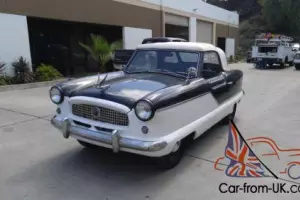 price: $60001957 Nash Metropolitan Couptavertible
price: $60001957 Nash Metropolitan Couptavertible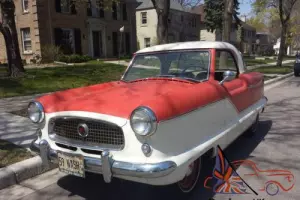 price: $120001959 Nash Metropolitan
price: $120001959 Nash Metropolitan
Latest arrivals:
-
$50000
-
$65000
-
$30000
-
$105000
-
$00
-
$395000
-
$1250000
-
$119950
-
$169000
-
$90000
-
$150000
-
$199500
-
$152500
-
$155000
-
$175000
-
$120000
-
$169000
-
$349000
-
$119950
-
$289950
